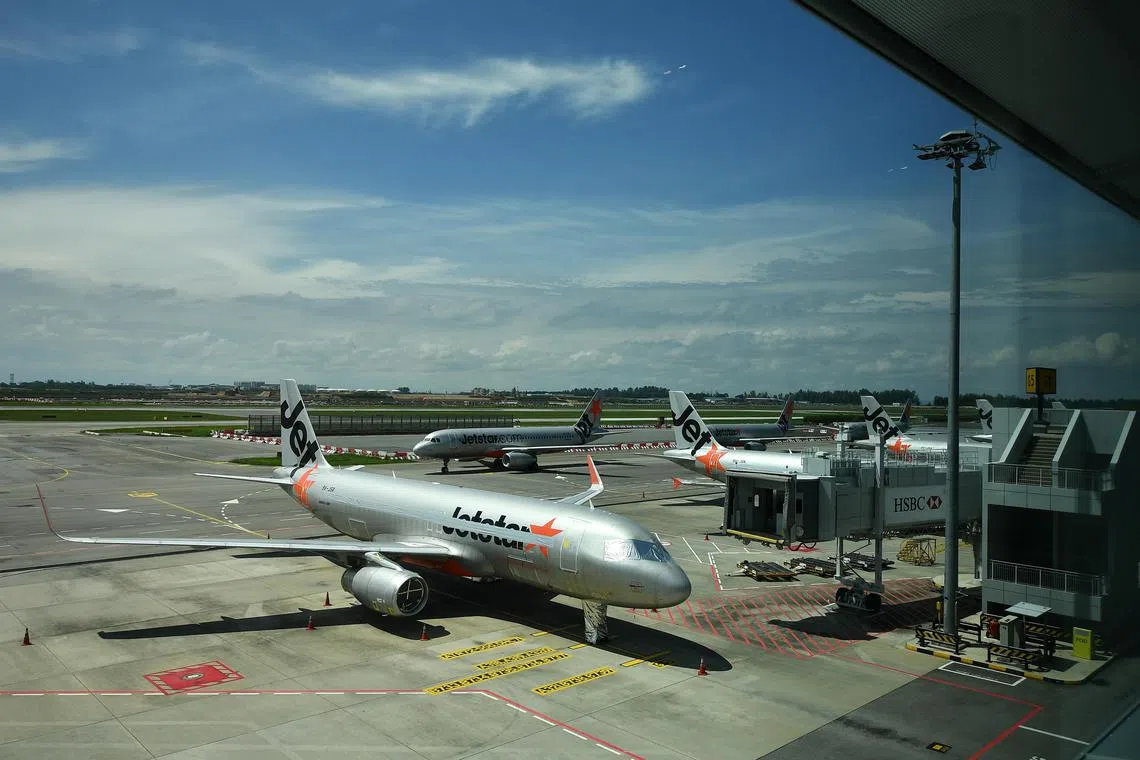The rise and fall of Singapore’s Jetstar Asia: A timeline
Sign up now: Get ST's newsletters delivered to your inbox

Jetstar Asia has been profitable for six out of the 20 years it has operated, said Jetstar Group's chief executive.
ST PHOTO: LIM YAOHUI
Follow topic:
SINGAPORE – Singapore-based low-cost carrier Jetstar Asia will cease operations after July 31
Australian flag carrier Qantas, Jetstar Asia’s parent company, said rising costs and stiff competition in the region had “fundamentally challenged” the budget airline’s ability to offer low fares.
Jetstar Asia has been profitable for six out of the 20 years it has operated, said Jetstar Group chief executive Stephanie Tully. She described the airline as having had “a challenged history”, particularly in the last two years.
Here is a look back at Jetstar Asia since it took off in 2004.
2004
In 2004, Qantas announced the launch of a low-cost carrier based in Singapore in April.
The $100 million carrier, later named Jetstar Asia, was Singapore’s third budget airline after privately owned Valuair and Singapore Airlines-backed Tiger.
The airline was owned by Qantas (49.9 per cent), Singapore investment company Temasek (19 per cent), and Singaporean businessmen Tony Chew (21.1 per cent) and Wong Fong Fui (10 per cent).
It started with seven regional destinations – Hong Kong, Jakarta, Manila, Pattaya in Thailand, Shanghai in China, Surabaya in Indonesia, and Taipei.
Jetstar Asia made its maiden flight to Hong Kong in December.
2005
Jetstar Asia and Valuair announced a merger in 2005, which doubled their existing fleet size to eight Airbus A320 planes.
The carriers came together under a single holding company called Orangestar, while retaining their maiden names.
Both struggled to make money in the face of rising fuel costs and reluctance by regional governments to open up their skies to foreign carriers.
2006
Orangestar sought fresh funding of $36 million in 2006, having almost exhausted the $60 million that was pumped in at the time of the merger. It said business had suffered from the lack of viable routes and an aggressive competitive landscape with new entrants.
2009
Temasek, in 2009, sold its stake in Jetstar Asia and Valuair to Qantas and Singaporean businessman Dennis Choo, a travel industry veteran.
The ownership revamp centred on Orangestar.
Qantas owned 45 per cent of the company, with Temasek having a 33.5 per cent stake alongside minority shareholders.
The acquisition of Orangestar shares was carried out via a new holding company, Newstar Investment Holdings.
Under the new ownership structure, Qantas owned 49 per cent of the airlines. Mr Choo held 51 per cent via his wholly owned Singapore-based company, Westbrook Investments, and his share was believed to be worth about $35 million.
2010
In 2010, Jetstar chose Singapore over rivals Kuala Lumpur, Bangkok and Ho Chi Minh City as its home in Asia, in a coup for Changi Airport.
The carrier nudged into Singapore’s long-haul market, which had previously been dominated by full-service carriers such as Singapore Airlines.
Its Singapore-Melbourne route became the first long-haul flight offered by a low-cost carrier out of Singapore.
2011
Increased passenger numbers and a wider regional network sent profits soaring, with earnings increasing from $6.9 million for the previous financial year to $18 million for the 12 months ended June 30, 2011.
During this period, Jetstar Asia’s capacity grew by 46 per cent as it extended its reach to more cities in the region.
2020
Jetstar Asia grounded all 18 of its A320s in March 2020, as the Covid-19 pandemic hammered the aviation sector.
The airline asked its 800 employees to take paid and unpaid leave, in addition to cancelling bonuses.
In June, Jetstar Asia let go of about 180 people – 26 per cent of its employees. Most of its remaining staff would stay furloughed until the end of the year.
The carrier also retired five aircraft, reducing the total fleet to 13 A320s.
2022
Jetstar Asia agreed in November 2022 to relocate its operations from Terminal 1 to Terminal 4
This came after months of talks between both parties, after the carrier initially rejected Changi Airport’s decision to shift its flights to T4.
2023
In 2023, Jetstar Asia shared plans to hire more than 200 pilots and cabin crew as part of efforts to rebuild capacity post-pandemic.
It also said two more A320 aircraft would join its fleet of seven by the end of 2023.
Between 2020 and 2022, the carrier had shed 11 A320s, reducing its fleet size from 18 to seven.
2025
Jetstar Asia announced on June 11, 2025, that it would cease operations on July 31 as part of a “strategic restructure” by its parent company Qantas.
Vanessa Paige Chelvan is a correspondent at The Straits Times. She writes about all things transport and pens the occasional commentary.


